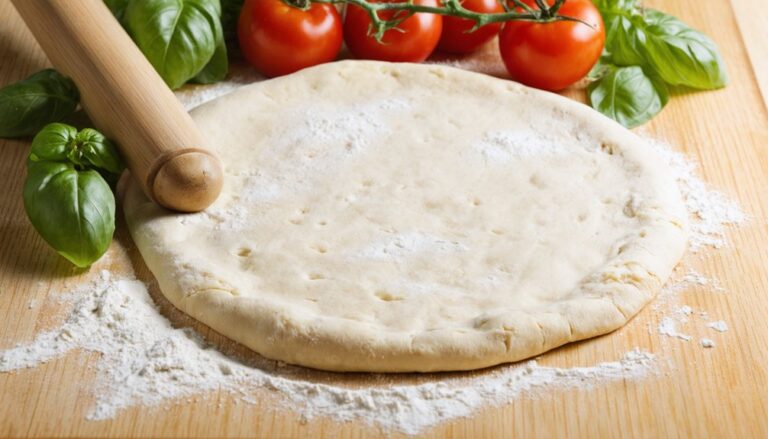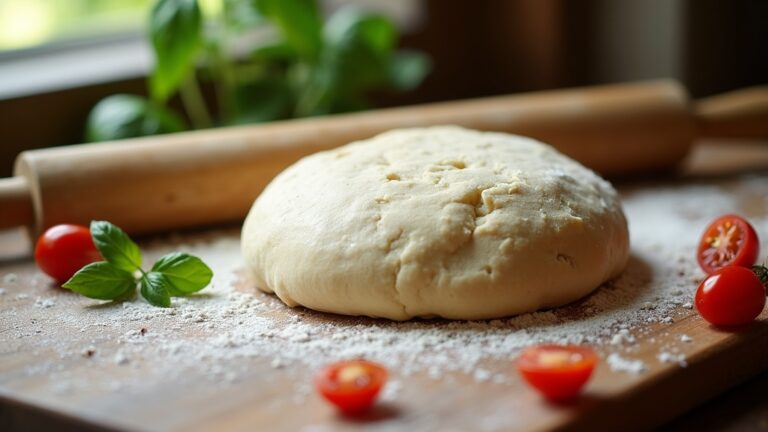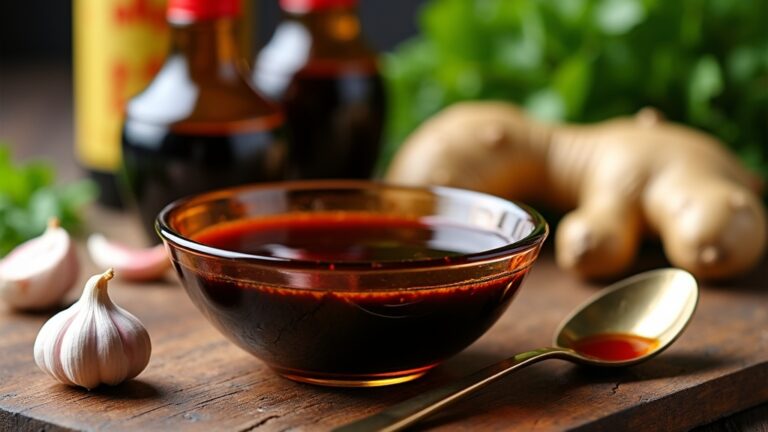Eel Sauce Recipe
Making eel sauce is simple and rewarding! I combine soy sauce, sugar, and mirin in a pot, then simmer until it reaches a glossy, syrupy texture. Adding a cornstarch slurry can help thicken it to my desired consistency. This sweet and savory sauce elevates sushi, grilled meats, and even veggies. It’s a versatile ingredient you’ll love in your kitchen! Stick around to discover more about its history and unique uses in various dishes.
Contents
History
When I plunge into the history of eel sauce, I’m fascinated by its roots in Japanese cuisine and the way it has evolved over time. Originally, this delightful concoction emerged from the eel origins of Japan, where chefs sought to enhance the natural flavors of grilled eel, or unagi. They discovered that a sweet and savory glaze made from soy sauce, sugar, and mirin perfectly complemented the rich taste of the fish. The culinary significance of eel sauce extends beyond just unagi; it’s become a beloved condiment for various dishes, from sushi to vegetables. As I explore its journey, I’m inspired by how tradition and innovation blend, making eel sauce a flavorful staple in kitchens worldwide.
Recipe
Eel sauce, also known as unagi sauce, is a sweet and savory glaze that is traditionally used in Japanese cuisine, particularly in dishes featuring grilled eel. This rich sauce can also enhance a variety of other dishes, such as sushi, grilled meats, and vegetables. With its glossy finish and complex flavors, eel sauce is surprisingly easy to make at home, allowing you to elevate your culinary creations without the need for store-bought options.
Eel sauce, a sweet and savory Japanese glaze, enhances sushi and grilled dishes with its rich flavor and glossy finish.
Creating your own eel sauce is a rewarding experience that allows you to control the flavors and sweetness levels to suit your taste. The key ingredients include soy sauce, mirin, and sugar, which come together to create a beautifully balanced sauce. Whether you’re planning to drizzle it over grilled fish, mix it into stir-fries, or use it as a dipping sauce, this homemade eel sauce will quickly become a staple in your kitchen.
Ingredients:
- 1 cup soy sauce
- 1 cup mirin
- 1/2 cup sugar
- 1 tablespoon cornstarch (optional, for thickening)
- 2 tablespoons water (optional, for cornstarch mixture)
To make the eel sauce, combine the soy sauce, mirin, and sugar in a saucepan over medium heat. Stir the mixture until the sugar is fully dissolved, then bring it to a gentle simmer. Allow the sauce to simmer for about 10-15 minutes, or until it thickens slightly. If you prefer a thicker sauce, mix the cornstarch with water to create a slurry, and then slowly add it to the simmering sauce, stirring constantly until it reaches your desired consistency. Remove the sauce from heat and let it cool before transferring it to a jar for storage.
When making eel sauce, it’s important to keep an eye on the cooking time to prevent it from becoming too thick or caramelizing. If you find that the sauce has thickened too much after cooling, you can always thin it out with a splash of water. Eel sauce can be stored in the refrigerator for up to two weeks, making it a convenient addition to your cooking repertoire. Feel free to adjust the sweetness or saltiness to your liking, and don’t hesitate to experiment by adding additional flavors like garlic or ginger for a unique twist!
Cooking Steps
Let’s get started on making that delicious eel sauce! First, I combine the soy sauce with the other ingredients, then I let it simmer with sugar for that perfect balance of flavor. Finally, I add mirin for sweetness and cornstarch to thicken it up before cooling and serving—it’s that simple!
Step 1. Combine Soy Sauce Ingredients
To create a rich and flavorful eel sauce, I start by gathering the essential soy sauce ingredients. I often opt for a combination of soy sauce varieties, like the smooth, umami-rich dark soy sauce and the lighter, saltier regular soy sauce. These ingredient combinations enhance the sauce’s depth and complexity. I pour equal parts of each into a mixing bowl, ensuring that I balance their flavors perfectly. If I’m feeling adventurous, I might even add a splash of tamari for a gluten-free twist or some shoyu for an authentic Japanese touch. Each variation adds its unique character, making my eel sauce truly innovative. Once I’ve combined these ingredients, I’m ready for the next steps in crafting this delectable sauce!
Step 2. Simmer With Sugar Added
As I bring the combined soy sauces to a gentle simmer, I carefully add in the sugar, transforming the mixture into a glossy, syrupy delight. For this step, I prefer using brown sugar for its rich depth, but granulated or coconut sugar can also work beautifully. The key lies in mastering simmering techniques—keeping the heat low guarantees the sugar dissolves evenly while preventing any scorching. I stir constantly, watching as the sauce thickens and the aroma fills my kitchen. This simmering process not only enhances the flavors but also creates that signature eel sauce texture. Once I achieve the perfect consistency, I know I’m one step closer to elevating my dishes with this innovative twist on a classic ingredient.
Step 3. Add Mirin for Sweetness
Adding mirin is an essential step in perfecting eel sauce, as it brings an extra layer of sweetness and complexity. This Japanese rice wine not only enhances the flavor but also offers remarkable mirin benefits, like deepening umami notes. When I add mirin, I aim for that perfect sweetness balance—neither too sugary nor overly salty. I pour in about two tablespoons, letting it meld with the simmering mixture of soy sauce and sugar. The fragrance is intoxicating, and I can already envision how it’ll elevate my dishes. If you’re seeking innovation in your cooking, don’t skip this step. Mirin transforms your eel sauce into a luxurious drizzle that complements any dish beautifully!
Step 4. Add Cornstarch for Thickness
While the sweetness of mirin enriches the flavor of your eel sauce, achieving the right thickness is equally important for that perfect drizzle. To enhance your sauce consistency, I recommend adding cornstarch. It’s a game-changer! Just mix a tablespoon of cornstarch with an equal amount of cold water to create a slurry. This simple step not only thickens the sauce but also gives it a velvety texture that clings beautifully to your eel. As you incorporate the slurry into your simmering sauce, watch it transform! The cornstarch benefits are clear: a luscious, glossy sauce that elevates your dish to new heights. Trust me, this is the secret to making your eel sauce irresistibly good!
Step 5. Cool and Serve Sauce
Once the sauce has reached that perfect consistency, it’s time to cool it down before serving. I usually transfer the eel sauce into a glass bowl and let it sit at room temperature for about 15 minutes. This cooling step allows the flavors to meld beautifully. For an innovative eel sauce pairing, consider drizzling it over grilled vegetables or sushi rolls for a gourmet touch. You can also serve it alongside fried rice or as a glaze for grilled fish. Don’t forget to garnish with sesame seeds or thinly sliced green onions for an added pop of flavor and color. Once it’s cooled, you’re ready to elevate any dish with your homemade eel sauce! Enjoy your culinary creation!
Nutritional Guide
When I whip up a batch of eel sauce, I can’t help but think about its nutritional profile, which can enhance our meals in more ways than one. This sauce not only adds flavor but also brings nutritional benefits to the table. For those looking for ingredient alternatives, experimenting with low-sodium soy sauce or adding a touch of honey can elevate health without sacrificing taste.
| Nutrient | Amount per Serving |
|---|---|
| Calories | 30 |
| Protein | 1g |
| Sugars | 6g |
| Sodium | 250mg |
Final Thoughts
As I reflect on the versatility of eel sauce, I realize how it can elevate not just sushi but a variety of dishes. This rich, umami-packed sauce brings a delightful sweetness that enhances grilled meats, roasted vegetables, and even seafood. I love experimenting with sauce variations, adding a dash of spice or a hint of citrus to create unique flavor profiles. When it comes to serving suggestions, drizzle it over rice bowls or use it as a marinade for proteins; the possibilities are endless. If you’re looking to innovate in your kitchen, eel sauce can be your secret weapon. Trust me, once you start incorporating it into your meals, you’ll wonder how you ever cooked without it!
Frequently Asked Questions
Can I Store Leftover Eel Sauce for Later Use?
Absolutely, I love storing leftover sauces! For the best sauce longevity, I recommend airtight containers in the fridge. Just remember, it’s always best to use it within a week for ideal flavor. Enjoy!
Is Eel Sauce Gluten-Free?
I know some might think eel sauce isn’t gluten-free, but many brands use gluten-free ingredients. If you’re looking for alternative recipes, just swap in tamari for soy sauce, and you’re good to go!
What Are Common Dishes That Use Eel Sauce?
When I think of dishes that use eel sauce, sushi rolls come to mind first. I also love drizzling it over grilled vegetables, adding a rich, umami flavor that elevates any meal to gourmet status.
Can I Substitute Eel Sauce With Another Sauce?
While eel sauce offers a unique umami punch, I’ve found alternative sauces, like teriyaki or soy mixed with sugar, can mimic its flavor profiles. Experimenting adds innovation to your dishes, so don’t hesitate to explore!
Where Can I Buy Eel Sauce?
If you’re wondering where to buy eel sauce, I’ve found online retailers and specialty stores offer great options. Exploring these places not only satisfies cravings but also introduces exciting new flavors to your kitchen adventures!
Conclusion
As I wrap up this journey into the world of eel sauce, I can’t help but wonder: how many culinary delights could we create if we embraced the art of homemade sauces? This rich, sweet, and umami-packed concoction not only elevates our dishes but also connects us to its storied history. So, why not give it a try? With just a few simple ingredients, you can bring a taste of tradition right into your kitchen. Happy cooking!








